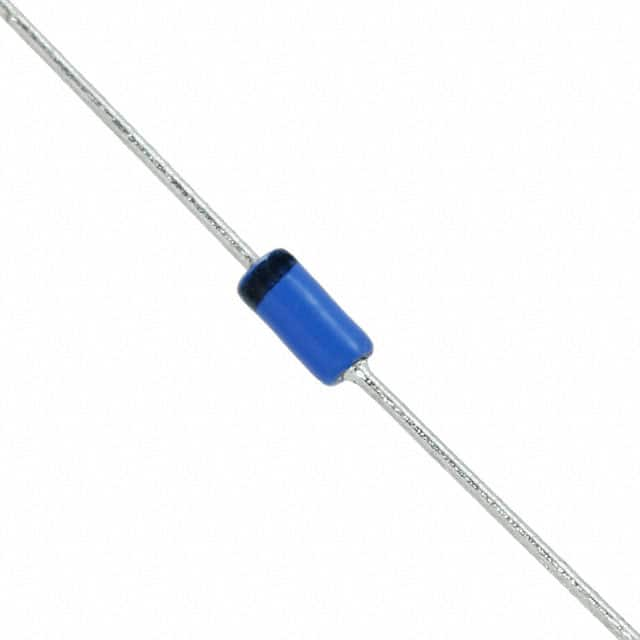BAT42 Diode
Product Overview
Category
The BAT42 diode belongs to the category of small signal Schottky diodes.
Use
It is commonly used in applications such as high-speed switching, clamping, and protection circuits.
Characteristics
- Low forward voltage drop
- Fast switching speed
- High reliability
Package
The BAT42 diode is typically available in a SOD-123 package.
Essence
This diode is essential for preventing reverse current flow and providing fast switching capabilities in electronic circuits.
Packaging/Quantity
The BAT42 diode is usually packaged in reels or tubes, with quantities varying based on manufacturer specifications.
Specifications
- Maximum repetitive peak reverse voltage: 30V
- Average rectified forward current: 200mA
- Non-repetitive peak forward surge current: 600mA
- Operating temperature range: -65°C to +125°C
Detailed Pin Configuration
The BAT42 diode has two pins, anode (A) and cathode (K), which are identified by a line on the cathode side of the diode symbol.
Functional Features
- Fast switching speed allows for rapid response in high-frequency applications.
- Low forward voltage drop minimizes power loss and enhances efficiency.
- High reliability ensures consistent performance over time.
Advantages and Disadvantages
Advantages
- Low forward voltage drop reduces power dissipation.
- Fast switching speed enables high-speed circuit operation.
- Small form factor makes it suitable for compact designs.
Disadvantages
- Limited maximum repetitive peak reverse voltage compared to other diodes.
- Lower average rectified forward current compared to some larger diodes.
Working Principles
The BAT42 diode operates based on the Schottky barrier principle, where the metal-semiconductor junction provides low forward voltage drop and fast switching characteristics.
Detailed Application Field Plans
High-Speed Switching Circuits
The BAT42 diode is ideal for use in high-speed switching circuits due to its fast switching speed and low forward voltage drop.
Clamping Circuits
In clamping circuits, the BAT42 diode can be used to limit the voltage level and protect sensitive components from overvoltage conditions.
Protection Circuits
Its ability to quickly respond to reverse voltage makes the BAT42 diode suitable for use in protection circuits to safeguard electronic components.
Detailed and Complete Alternative Models
Some alternative models to the BAT42 diode include: - BAT43: Similar characteristics with higher maximum repetitive peak reverse voltage. - 1N5711: Comparable Schottky diode with different packaging options. - HSMS-286x: Surface mount Schottky diode with similar specifications.
In conclusion, the BAT42 diode offers fast switching speed, low forward voltage drop, and high reliability, making it well-suited for various applications in electronics. Its compact size and efficient performance make it a popular choice for designers seeking to optimize circuit performance while minimizing power loss.
[Word Count: 411]
Senaraikan 10 soalan dan jawapan biasa yang berkaitan dengan aplikasi BAT42 dalam penyelesaian teknikal
Sure, here are 10 common questions and answers related to the application of BAT42 in technical solutions:
What is BAT42?
- BAT42 is a small signal Schottky diode used for general purpose applications.
What are the typical applications of BAT42?
- BAT42 is commonly used in high-speed switching applications, voltage clamping, and protection circuits.
What is the maximum forward voltage of BAT42?
- The maximum forward voltage of BAT42 is typically around 0.45V at a forward current of 1mA.
What is the reverse breakdown voltage of BAT42?
- The reverse breakdown voltage of BAT42 is typically around 30V.
Can BAT42 be used for low noise applications?
- No, BAT42 is not suitable for low noise applications due to its Schottky barrier design.
What is the maximum forward current of BAT42?
- The maximum forward current of BAT42 is typically around 200mA.
Is BAT42 suitable for high frequency applications?
- Yes, BAT42 is suitable for high frequency applications due to its fast switching characteristics.
Can BAT42 be used in temperature-sensitive applications?
- BAT42 has a relatively stable performance over a wide temperature range, making it suitable for temperature-sensitive applications.
What are the package options available for BAT42?
- BAT42 is available in various surface mount and through-hole package options, such as SOD-123, SOD-323, and DO-35.
Are there any specific layout considerations when using BAT42 in a circuit?
- It's important to minimize the length of traces and keep the diode close to the components it is interacting with to minimize parasitic effects and ensure optimal performance.
I hope these questions and answers are helpful! Let me know if you need further assistance.


